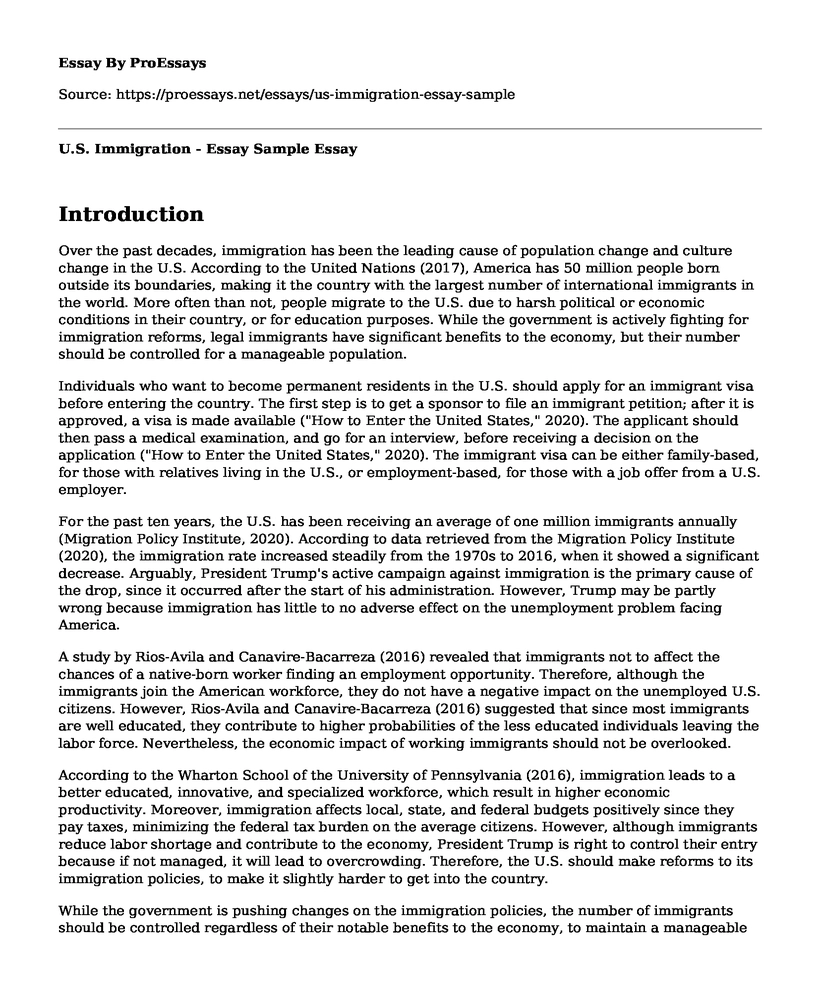Introduction
Over the past decades, immigration has been the leading cause of population change and culture change in the U.S. According to the United Nations (2017), America has 50 million people born outside its boundaries, making it the country with the largest number of international immigrants in the world. More often than not, people migrate to the U.S. due to harsh political or economic conditions in their country, or for education purposes. While the government is actively fighting for immigration reforms, legal immigrants have significant benefits to the economy, but their number should be controlled for a manageable population.
Individuals who want to become permanent residents in the U.S. should apply for an immigrant visa before entering the country. The first step is to get a sponsor to file an immigrant petition; after it is approved, a visa is made available ("How to Enter the United States," 2020). The applicant should then pass a medical examination, and go for an interview, before receiving a decision on the application ("How to Enter the United States," 2020). The immigrant visa can be either family-based, for those with relatives living in the U.S., or employment-based, for those with a job offer from a U.S. employer.
For the past ten years, the U.S. has been receiving an average of one million immigrants annually (Migration Policy Institute, 2020). According to data retrieved from the Migration Policy Institute (2020), the immigration rate increased steadily from the 1970s to 2016, when it showed a significant decrease. Arguably, President Trump's active campaign against immigration is the primary cause of the drop, since it occurred after the start of his administration. However, Trump may be partly wrong because immigration has little to no adverse effect on the unemployment problem facing America.
A study by Rios-Avila and Canavire-Bacarreza (2016) revealed that immigrants not to affect the chances of a native-born worker finding an employment opportunity. Therefore, although the immigrants join the American workforce, they do not have a negative impact on the unemployed U.S. citizens. However, Rios-Avila and Canavire-Bacarreza (2016) suggested that since most immigrants are well educated, they contribute to higher probabilities of the less educated individuals leaving the labor force. Nevertheless, the economic impact of working immigrants should not be overlooked.
According to the Wharton School of the University of Pennsylvania (2016), immigration leads to a better educated, innovative, and specialized workforce, which result in higher economic productivity. Moreover, immigration affects local, state, and federal budgets positively since they pay taxes, minimizing the federal tax burden on the average citizens. However, although immigrants reduce labor shortage and contribute to the economy, President Trump is right to control their entry because if not managed, it will lead to overcrowding. Therefore, the U.S. should make reforms to its immigration policies, to make it slightly harder to get into the country.
While the government is pushing changes on the immigration policies, the number of immigrants should be controlled regardless of their notable benefits to the economy, to maintain a manageable population. Immigrants have little to no adverse effect on the unemployment problem in the U.S. Conversely, they provide a better educated, innovative, and specialized workforce, which result in higher economic productivity, and affect the local, state, and federal budget positively. However, the U.S. should make reforms to its immigration policies, to make it slightly harder to get into the country, to prevent overcrowding in the country.
References
How to Enter the United States | USAGov. (2020, January 27). USA.gov: The U.S. Government's Official Web Portal | USAGov. https://www.usa.gov/enter-us
Migration Policy Institute. (2020, February 13). U.S. Immigrant Population and Share over Time, 1850-Present. https://www.migrationpolicy.org/programs/data-hub/charts/immigrant-population-over-time
Rios-Avila, F., & Canavire-Bacarreza, G. J. (2016). Unemployed, Now What? The Effect of Immigration on Unemployment Transitions of Native-Born Workers in the United States. SSRN Electronic Journal. https://doi.org/10.2139/ssrn.2827120
United Nations. (2017). 2017 Migration Report. https://www.un.org/en/development/desa/population/migration/publications/migrationreport/docs/MigrationReport2017_Highlights.pdf&ved=2ahUKEwiOnN_dqvfnAhUS2BoKHZPUATkQFjABegQIBBAI&usg=AOvVaw3jx3P1g0CjbWriFlqOIt8t
Wharton School of the University of Pennsylvania. (2016, June 27). The Effects of Immigration on the United States' Economy - Penn Wharton Budget Model. Penn Wharton Budget Model. https://budgetmodel.wharton.upenn.edu/issues/2016/1/27/the-effects-of-immigration-on-the-united-states-economy
Cite this page
U.S. Immigration - Essay Sample. (2023, Apr 10). Retrieved from https://proessays.net/essays/us-immigration-essay-sample
If you are the original author of this essay and no longer wish to have it published on the ProEssays website, please click below to request its removal:
- The Ugly Truth of Drug Addiction Essay
- The Success and Failure of Terror Groups Paper Example
- Gender Discrimination at Workplaces Essay
- Annotated Bibliography on Mexican Drug Cartels: Thriving Despite Security Measures
- Cora's Domestic Violence: A Case Study of Social Care Inaction
- Migrant Detention: A Global Crisis for Refugee and Immigrant Children - Essay Sample
- Exploring Gender-Based Violence: Rape and its Impact - Essay Sample







